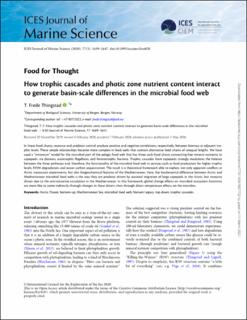| dc.contributor.author | Thingstad, Tron Frede | |
| dc.date.accessioned | 2021-08-04T09:10:14Z | |
| dc.date.available | 2021-08-04T09:10:14Z | |
| dc.date.created | 2021-01-11T11:17:15Z | |
| dc.date.issued | 2020 | |
| dc.identifier.issn | 1054-3139 | |
| dc.identifier.uri | https://hdl.handle.net/11250/2766138 | |
| dc.description.abstract | In linear food chains, resource and predator control produce positive and negative correlations, respectively, between biomass at adjacent trophic levels. These simple relationships become more complex in food webs that contain alternative food chains of unequal lengths. We have used a “minimum” model for the microbial part of the pelagic food web that has three such food chains connecting free mineral nutrients to copepods: via diatoms, autotrophic flagellates, and heterotrophic bacteria. Trophic cascades from copepods strongly modulates the balance between the three pathways and, therefore, the functionality of the microbial food web in services such as food production for higher trophic levels, DOM degradation, and ocean carbon sequestration. The result is a theoretical framework able to explain, not only apparent conflicts in Arctic mesocosm experiments, but also biogeochemical features of the Mediterranean. Here, the fundamental difference between Arctic and Mediterranean microbial food webs is the way they are predator driven by seasonal migration of large copepods in the Arctic, but resource driven due to the anti-estuarine circulation in the Mediterranean. In this framework, global change effects on microbial ecosystem functions are more like to come indirectly through changes in these drivers than through direct temperature effects on the microbes. | en_US |
| dc.language.iso | eng | en_US |
| dc.publisher | Oxford University Press | en_US |
| dc.rights | Navngivelse 4.0 Internasjonal | * |
| dc.rights.uri | http://creativecommons.org/licenses/by/4.0/deed.no | * |
| dc.title | How trophic cascades and photic zone nutrient content interact to generate basin-scale differences in the microbial food web | en_US |
| dc.type | Journal article | en_US |
| dc.type | Peer reviewed | en_US |
| dc.description.version | publishedVersion | en_US |
| dc.rights.holder | Copyright 2020 International Council for the Exploration of the Sea | en_US |
| cristin.ispublished | true | |
| cristin.fulltext | original | |
| cristin.qualitycode | 1 | |
| dc.identifier.doi | 10.1093/icesjms/fsaa028 | |
| dc.identifier.cristin | 1868753 | |
| dc.source.journal | ICES Journal of Marine Science | en_US |
| dc.source.pagenumber | 1639–1647 | en_US |
| dc.relation.project | Norges forskningsråd: 276730 | en_US |
| dc.identifier.citation | ICES Journal of Marine Science. 2020, 77(5), 1639–1647 | en_US |
| dc.source.volume | 77 | en_US |
| dc.source.issue | 5 | en_US |

